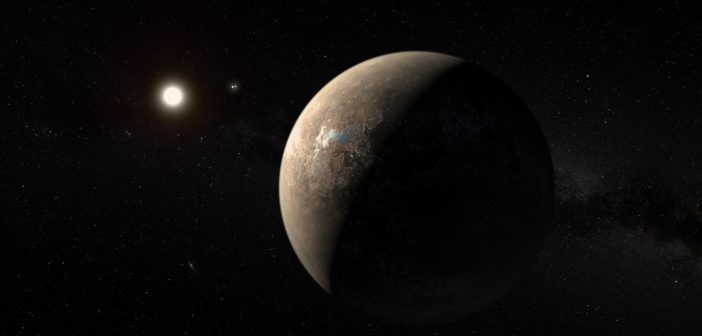Editor’s note: Astrobites is a graduate-student-run organization that digests astrophysical literature for undergraduate students. As part of the partnership between the AAS and astrobites, we repost astrobites content here at AAS Nova once a week. We hope you enjoy this post from astrobites; the original can be viewed at astrobites.org!
Title: Detecting Proxima b’s Atmosphere with JWST Targeting CO2 at 15 Micron Using a High-Pass Spectral Filtering Technique
Author: I.A.G. Snellen, J.M. D’esert, L.B.F.M. Waters, T. Robinson, et al.
First Author’s Institution: Leiden Observatory, Leiden University, The Netherlands
Status: Accepted to AJ, open access
Proxima Centauri b and the Significance of CO2
This summer marks the one-year anniversary of the detection of an exoplanet orbiting our solar system’s nearest stellar neighbor, Proxima Centauri. This Earth sized exoplanet, with the oh-so-imaginative name Proxima Centauri b, lies in the habitable zone of its M-dwarf star. As we’ve previously discussed, having such an Earth-like planet in our stellar backyard is really exciting, and astronomers are keen to explore the system as thoroughly as possible for potential signs of life. The cover image above shows an artist’s rendition of this intriguing exoplanet.
Since the discovery of this close planet, researchers have been studying methods that might detect the presence of life on Proxima Centauri b. Today’s paper approaches this by devising a method to detect carbon dioxide (CO2) in the planet’s atmosphere. The authors focus on this particular molecule because it is one of the four main biomarkers used in evaluating habitability of exoplanets; water, methane, carbon dioxide, and oxygen are primarily produced during biological processes, so their presence in an atmosphere can imply life. In addition to being a biomarker molecule, CO2 has many distinguishable features that are visible in the 15 micron band, which JWST is equipped to look at.
Snellen and collaborators present a technique that can be performed with the soon-to-be-launched James Webb Space Telescope (JWST), which would reveal the presence of CO2 in the atmosphere of this nearby exoplanet. The emission in the 15 micron band will be ideal for detecting CO2, since this molecule has over 100 features within this band.
JWST and High-Pass Spectral Filtering Techniques
JWST is equipped with several extremely sensitive instruments. One of the goals of this mission is to detect and characterize atmospheres of exoplanets. With this in mind, these authors suggest using the medium resolution spectrograph (MRS) mode of the Mid-Infrared Instrument (MIRI) to detect CO2 markers in the atmosphere of Proxima Centauri b.

Figure 1: This shows an example planet spectrum and high-pass filtered spectrum. The high-pass image has more distinguishable features, which allows for greater sensitivity in molecule detection. [Snellen et al. 2017]
The authors used atmospheric models of Proxima Centauri b to show the limits of their detection method in extreme cases and expected results which are shown in Figure 2.

Figure 2: Planet model spectra, assuming a standard Earth atmospheric model for the temperatures and gas mixing ratios. The temperature and pressure relation is shown on the right column. The left column has the observed spectra given the temperature profiles. The upper panel has stratospheric temperatures that are equal to the tropopause temperature; the middle panel shows a model for clear sky conditions with an Earth-like temperature profile; the lower panel shows the spectrum for high, thick cloud coverage, again with an Earth-like temperature profile. [Snellen et al. 2017]
A Step Forward in the Search for Extraterrestrial Life
If we can detect exoplanet life or a habitable exoplanet so close to Earth, this could tell us more about how common life is in our universe and the origins of life in different environments. Until we find a way to accurately detect the presence of life, such as detecting CO2 in atmospheres, we won’t know the extent of life in all parts of the universe. Though we don’t know for certain yet, I for one hope that we can soon discover and say hello to our new alien neighbors, hopefully on Proxima b!
About the author, Mara Zimmerman:
Mara is working on her PhD in Astronomy at the University of Wyoming. She has done research with binary stars, including Heartbeat stars, and currently works on modeling debris disks.

1 Comment
Pingback: Detecting Exoplanet Life in Our Proximity – MeasurementDataBases for Industry & Science